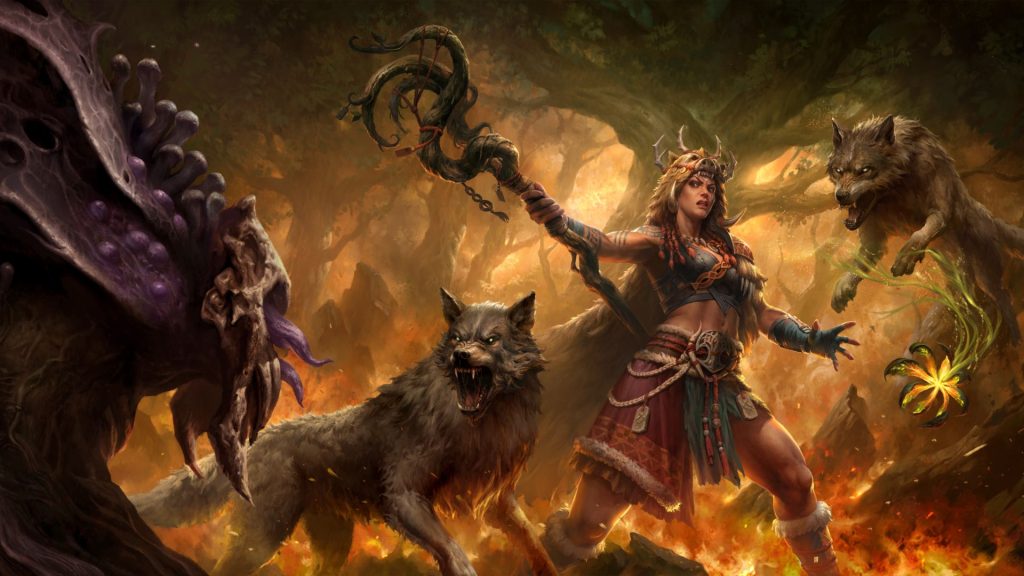As players gear up for the latest installment of the renowned action RPG series, Diablo Immortal, the excitement surrounding the introduction of the Druid class on July 3 is palpable. This character class, which embodies the essence of the wilderness, is renowned for its blend of feral instincts, nature-based magic, and an unwavering spirit of survival. As we prepare to immerse ourselves in the latest chapter of the Diablo saga, let’s take a closer look at the captivating evolution of the Druid class through its storied history.
Origins of the Druid
The Druid class has deep roots in the lore of the Diablo universe. These enigmatic characters are depicted as guardians of nature, forming a deep, spiritual bond with the environment around them. Unlike their counterparts, the Barbarians, who embrace brute strength, Druids harness the forces of nature with grace and precision. This dichotomy paints a vivid picture of their identity: the serene protector of the wild, capable of transforming into a fearsome beast when provoked.
Drawing inspiration from European mythology, particularly Celtic and Germanic traditions, the Druid class incorporates themes of shamanism and natural magic. Yet, in the grim world of Sanctuary, Druids are reimagined to reflect the harsh realities of their environment, where survival often hinges on a delicate balance between ferocity and mysticism. As players delve into the lore, they discover that Druids are more than just warriors; they are stewards of nature, wielding its power against the evils that threaten their world.
The Druid’s Skill Set
The Druid class is marked by its dynamic skillset, which combines elemental magic, shapeshifting abilities, and the power to summon animal companions. Each of these facets contributes to a diverse range of playstyles and strategic approaches in combat:
- Elemental Magic: The Druid can unleash devastating spells harnessing the raw power of nature, from summoning thunderstorms to creating earth-shaking quakes. These elemental abilities not only deal significant damage but also underscore the class’s connection to the natural world.
- Summoning Companions: Players can call upon a variety of animal allies—such as robust bears or swift wolves—to aid them in battle. These companions enhance the Druid’s combat capabilities, serving as distractions for enemies or dealing critical damage alongside their master.
- Shapeshifting: The ability to transform into a formidable Werebear or a nimble Werewolf adds a visceral dimension to the gameplay, allowing players to adapt their tactics on the fly. This transformation reflects a deep connection to the primal forces that define the Druid’s identity.
The Druid’s Evolution
Since its debut in Diablo II, the Druid class has seen various refinements and iterations, each building upon its foundational identity while adapting to new gameplay mechanics:
Diablo II (2000)
The Druid made a lasting impression upon its initial introduction in Diablo II, offering players a unique blend of shapeshifting capabilities and elemental magic. Players could choose to transform into a fearsome werewolf or a powerful werebear, each with distinct combat advantages. Elemental spells further expanded their versatility, enabling Druids to unleash the destructive forces of nature. The class’s narrative stood out, enhancing the mystique surrounding its lore and its connection to the natural world.
Diablo IV (2023)
In the latest title, Diablo IV, the Druid has evolved to offer even greater flexibility and options for players. Stunning visuals accompany earth and storm spells, allowing players to summon earthquakes and lightning storms to disrupt their foes. Additionally, the ability to shift fluidly between forms—human, werewolf, and werebear—has been enhanced with item customization, enabling hybrid builds that enrich gameplay. Totems serve as specialized off-hand items, providing tailored bonuses that further enhance the Druid’s arsenal, reinforcing their role as guardians of nature.
Diablo Immortal (2022)
As the most recent addition to the Diablo series, the Druid’s presence in Diablo Immortal channels an untamed, primal energy, representing a departure from previous iterations. This version of the Druid embodies a wild and reckless spirit, characterized as a hermit who embraces the chaotic forces of nature. The introduction of Wild Magic offers a focused yet adaptable skill set, allowing players to shape the battlefield with feral precision through both melee combat and summoning abilities. This new take on the Druid emphasizes both their unpredictability and their intimate connection to the natural world.
Community Responses and Legacy
The response from the Diablo community regarding the evolution of the Druid class has been overwhelmingly positive. Fans appreciate the class’s growth and adaptability, noting that it balances nostalgia with modern gameplay mechanics. Players feel a strong emotional connection to the Druid, often citing memorable experiences and epic moments during gameplay. Many have shared stories of their most exhilarating battles as shapeshifting beasts or their favorite moments commanding nature itself. Engaging with the broader Diablo community on social platforms has allowed players to exchange tips and insights, further enriching the overall experience.
Join the Pack
The Druid class demonstrates a timeless fantasy, skillfully blending ferocity and serenity in gameplay. Whether commanding nature’s forces, shapeshifting into powerful beasts, or summoning animal allies, Druids provide an immersive and customizable player experience. As the Diablo Immortal release date approaches, fans eagerly anticipate diving back into the shoes of this iconic class.
What are your most cherished Druid moments in the Diablo series? Share your stories on social media and within the community to connect with fellow players and stay updated on the latest news and developments in the Diablo universe.

